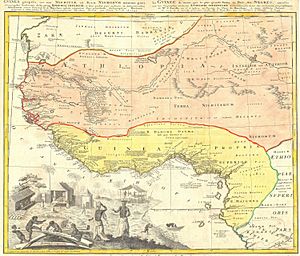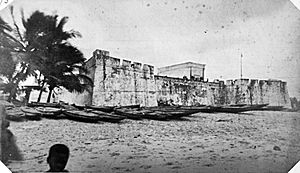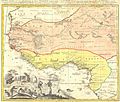Venture Smith facts for kids
Venture Smith (born Broteer Furro) (around 1729 – 1805) was an African-American farmer and craftsman. When he was about six years old, Venture was kidnapped in West Africa. He was taken to Anomabo on the Gold Coast (now Ghana) to be sold into slavery. As an adult, he worked hard to buy his own freedom and the freedom of his family.
Venture Smith wrote down his life story in a book. It was called A Narrative of the Life and Adventures of Venture, a Native of Africa: But Resident above Sixty Years in the United States of America, Related by Himself. This book is one of the first life stories written by an African American. Only a few people who were enslaved left behind their own accounts of what happened to them.
Robinson Mumford, Venture's first white enslaver, gave him the name "Venture." Mumford thought buying him was like a business "venture." He bought Venture for four gallons of rum and a piece of calico. After becoming free, Smith took his last name from Oliver Smith, the last person who enslaved him. In his book, Venture described his people as being very tall and strong. He said he was over 6 feet 1+1⁄2 inches (1.87 m) tall and weighed 230 pounds (100 kg). He often carried a 9-pound (4.1 kg) axe for cutting trees. This information has been supported by studies and old records.
Venture Smith passed away in 1805. He is buried at the First Church of Christ cemetery in East Haddam, Connecticut. This cemetery is now a stop on the Connecticut Freedom Trail.
Contents
Venture Smith's Story
His Early Life in Africa
Broteer (Venture Smith) was born in a place he called Dukandarra in "Guinea." At that time, "Guinea" was a name for a large part of West Africa. Historians believe Dukandarra was likely in the Savannah region.
His father was Saungm Furro, the prince of Dukandarra. His mother was the first of his father's three wives. Broteer was her first child. His mother left Saungm Furro's village after he married another wife without her permission. She took her three children with her. They traveled about 140 miles over four days, finding food along the way. Young Broteer stayed with a rich farmer while his mother went to her home country. On the farm, Broteer took care of 40 sheep. He stayed there for about a year before his father sent someone to bring him back home.
Six weeks after returning to his father's village, Broteer learned that the farmer's country had been attacked. A large army had invaded. The people there were not ready for war, so they had to leave their homes. Saungm Furro agreed to help them by offering a safe place to stay. Soon after the refugees arrived, an enemy messenger came. He demanded a lot of money, 300 cattle, and many goats, sheep, and donkeys. The threat of war was enough for Saungm Furro to agree to their demands.
Even after paying the enemy, Saungm Furro's village was attacked by 6,000 men. Broteer, his family, and everyone in the village ran away. Along the way, Saungm Furro found some enemy scouts and shot arrows at them. Soon, everyone was captured. Saungm Furro was questioned because the invaders knew he had money. He died during questioning because he would not tell them where his money was hidden. This event stayed with Broteer for his whole life. He said, "the shocking scene is to this day fresh in my mind."
The invaders forced the captives to march about 1,000 miles to Malagasco and the coast. They also captured more Africans along the way. Later, the captors were attacked and defeated by a local group. But instead of being set free, Broteer remained enslaved. He continued his journey to the coast and finally reached Anomabu. In the spring of 1739, a slave ship carrying Broteer sailed from Anomabo to Barbados. It had 260 captives. Then it went to Rhode Island.
On board the ship, Broteer was bought by Robinson Mumford of Rhode Island. He was bought for four gallons of rum and a piece of calico. He was then renamed "Venture." During the journey to Barbados, many people got smallpox. About 60 of his fellow captives died. Most of the people who survived were sold in Barbados. But Venture was brought to New England.
Life in America and Freedom
Venture Smith's story tells that when the ship arrived in Barbados, most of the enslaved people were sold. This happened on August 23, 1739. Venture and three others sailed on to Rhode Island, arriving in the fall of 1739. Venture then went to live at Mumford's home on Fishers Island, New York. There, he was forced to work in the house. He worked hard and was trusted more and more by his enslaver. He was praised for guarding his enslaver's chest for a long time.
However, Venture had to do very hard work from a young age. He also faced harsh punishments. His enslaver's son, in particular, treated him badly. As Venture grew older, he had to do even tougher jobs and received severe punishments.
Venture married an enslaved woman named Meg (Margaret) when he was 22. Soon after, on March 27, 1754, he tried to escape. An Irish indentured servant named Heddy and two other enslaved people convinced him to run away. During their escape at Montauk Point, Long Island, Heddy tried to steal their supplies. Venture and his friends caught Heddy and returned him to his enslaver. They were welcomed back for their efforts.
In 1754, Venture and his wife had a daughter named Hannah. Less than a month later, Venture was separated from his family. He was sold to Thomas Stanton in Stonington, Connecticut. They were reunited the next year when Stanton bought Meg and Hannah. Venture began saving money from extra jobs and selling crops he grew. He hoped to buy freedom for his family.
His time with the Stantons started peacefully. But one day, Venture found his wife and Mrs. Stanton arguing. Mrs. Stanton was hitting his wife with a stick. When Venture tried to stop the fight, Mrs. Stanton turned the stick on him. Venture took the stick from her and threw it into the fire. Because of this, Thomas Stanton attacked Venture with a boat oar. Venture defended himself. He then went to the local authorities to complain about the abuse. Stanton and his brother, who came to hurt Venture, received a strong warning and were shamed in public. In revenge, the brothers attacked Venture again when they were out of sight. But Venture fought them off again.
Because of these difficult events, Venture decided he needed to become free from the Stantons. The Smiths had two more children, Solomon in 1756 and Cuff in 1761. Venture was sold two more times. In 1760, he was enslaved by Captain Oliver Smith. Captain Smith agreed to let Venture buy his freedom. Venture was allowed to work for money when he was not needed at home. Finally, in the spring of 1765, Venture Smith bought his freedom for 71 pounds and two shillings. This was a very high price.
A Free Man's Life
After gaining his freedom, Venture Smith moved to Long Island. In 1769, he earned money by cutting wood. He then used this money to buy his sons, Solomon and Cuff. He said he cut over 400 cords of wood and threshed 75 bushels of grain in six months to earn the money. He paid 200 dollars for each of his sons.
He hired out Solomon, his oldest son, to Charles Church for one year. Solomon was 17 and strong. Venture hoped Solomon would help him. Church paid 12 pounds and offered Solomon a bonus of silver buckles if he joined a whaling trip. When Venture heard about the trip, he tried to stop his son. But when he arrived, he could only see the boat far away on the horizon. Venture never saw his oldest son again. Solomon caught scurvy and died during the trip.
Soon after his son's death, Venture bought his wife for 40 pounds. He did this quickly because she was pregnant. If she had given birth before he bought her, he would have had to buy both his wife and the child separately. After welcoming another son, Venture named him Solomon, in memory of his first son.
Venture Smith faced many challenges with money and his family. His daughter, Hannah, got married. But then she became ill. Her husband did not take good care of her. Even though Venture nursed her, she died. Also, two people he had bought ran away. In his early sixties, he was unfairly accused of losing a white man's property and had to pay ten pounds. This happened while he was visiting New London. Even though he was not there and had witnesses, he was still found guilty. Smith took this matter to other courts, saying he was innocent. But the decision was never changed. This unfair judgment was made because of unfair treatment against Black people. Thinking about this, he said: "Captain Hart was a white gentleman, and I a poor African, therefore it was all right, and good enough for the black dog."
In 1775, Smith bought a farm at Haddam Neck, on the Salmon River, in Connecticut. By 1778, he had made his farm much bigger, from 10 acres to at least 130 acres. He also earned money by fishing, whaling, farming his land, and trading in the Long Island area. He lived the rest of his life at Haddam Neck.
In 1798, Venture Smith told his life story. His family helped him have it printed by The Bee in New London, Connecticut. By this time, Venture was getting old. His strong, tall body was bent, and he was losing his eyesight. Some people thought his story might have been changed by the white editor. This was common for slave narratives at the time. But after many studies, most experts believe the book is truly Venture Smith's own words. The book is called A Narrative of the Life and Adventures of Venture, a Native of Africa: But Resident above Sixty Years in the United States of America.
Images for kids





